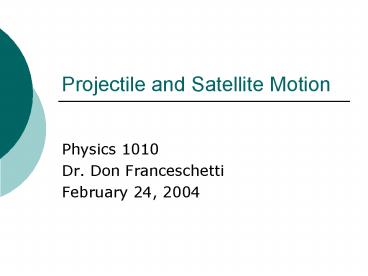Projectile and Satellite Motion PowerPoint PPT Presentation
1 / 21
Title: Projectile and Satellite Motion
1
Projectile and Satellite Motion
- Physics 1010
- Dr. Don Franceschetti
- February 24, 2004
2
Review
- Q 7.3 Cite an example when a force is exerted on
an object without doing any work on the object. - Q. 7.7 How many watts of power are expended when
a force of 1 N moves a book 2 m in a time
interval of 1 s?
3
Review
- Q7.22, Can a machine multiply input force? Input
distance? Input energy? - Q7.33 If a moving object doubles its speed, how
much more momentum does it have? How much more
energy?
4
Review
- Ex7.2 Which requires more work to stopa light
truck or a heavier one that has equal speed. - Prob 7.2 A car moving at 50 km/h skids 15 m car
skid with locked brakes at with locked brakes.
How far will car skid at 150 km/h?
5
Review
- Q 8.8 What is rotational inertia, and how does
it compare to inertia as studied in previous
chapters? - Q 8.9 Inertia depends on mass rotational inertia
depends on mass and something else. What? - Q 8.13 Why does bending your legs when running
enable you to swing your legs to and fro more
rapidly?
6
Review
- Q 8.32 How can gravity be simulated in an
orbiting space station? - Q 8.33 Why will orbiting space stations that
simulate gravity likely be large structures?
7
Review
- Q 8.23 Why is the wobbly motion of a single star
an indication that the star has one or more
planets orbiting around it? - Q8.24 Why must you bend forward when carrying a
heavy load on your back?
8
Review
- Q 9.1 What was it that Newton discovered about
gravity? - Q 9.5 What is the magnitude of the gravitational
force between two 1-kg bodies that are one meter
apart. - Q 9.6 What is the magnitude of the gravitational
force between the Earth and a 1-kg body.
9
Review
- Ex 9.1 Gravitational force acts on all bodies in
proportion to their masses. Why, then, doesnt a
heavy body fall faster than a light body. - Ex 9.10 Somewhere between the Earth and the moon,
gravity from these two bodies on a space pod
would cancel. Is this location nearer the Earth
or moon?
10
Projectiles
- A projectile is any object that is projected by
some means and continues in motion by its own
inertia. - Main classes are weapons bullets, arrows,
artillery shells, bombs, rocks and balls
baseballs, footballs, golf balls
11
Projectiles
- Are in free fall, neglecting air resistance
- The horizontal component of velocity does not
change because the net force acting has zero
horizontal component - The vertical component changes in response to the
gravitational force.
12
Projectile motion by superposition
- Projectiles launched horizontally
- Upwardly launched projectiles
- Range is same for angle and complementary angle.
- Greatest range for projectiles launched at 45
degrees.
13
Fast moving projectiles satellites
- Circular orbits
- Near earth 90 minute period
- Orbital sped 8km/s, near Earths surface
- Geosynchronous, 24 hour period, orbital speed is
less - Elliptic orbits
- Keplers laws apply
14
Energy Conservation and Satellite Motion
- Terminology
- Apogee, most distant point from Earth
- Potential energy is greatest
- Kinetic energy is least, motion is slowest
- Perigee, closest approach to Earth
- Potential energy is least
- Kinetic energy is greatest, speed is hight
- Perihelion, aphelion, apply to planet and Sun
15
Escape speed
- Minimum speed needed to escape planet
- from Earth is 11.2 km/s.
- From Sun at Earth orbit is 42.2 km/s
- Pioneer 10 left Earth in 1972 at 15km/s used
gravitational assist from Jupiter.
16
Review
- Q10.5 A rock is thrown upward at an angle. What
happens to the horizontal component of its
velocity as it rises? As it falls? - Q10.6 A rock is thrown upward at an angle. What
happens to the vertical component of its velocity
as it rises? As it falls?
17
Review
- Q 10.14 Are the planets of the solar system
simply projectiles falling around the sun? - Q 10.18 Why does the force of gravity change the
speed of a satellite in an elliptical orbit.
18
Review
- Q10.25 Why is the kinetic energy a constant for
a satellite in circular orbit? - Q 10.26 Why is kinetic energy a variable for a
satellite in an elliptical orbit?
19
Review
- E10.4 In the absence of air drag, why does the
horizontal component of a projectiles motion not
change, while the vertical component does? - E10.9 When a rifle is being fired at a distant
target, why isnt the barrel lined up so that it
points exactly at the target?
20
Review
- E10.15 Since the moon is gravitationally
attracted to earth, why does it not simply crash
into the Earth? - E10.16 When the space shuttle coasts in a
circular orbit at constant speed about the Earth,
is it accelerating? If so, in what direction? If
not, why not?
21
Review
- E10.18 Does the speed of a falling object depend
on its mass? Does the speed of a satellite in
orbit depend on its mass?

